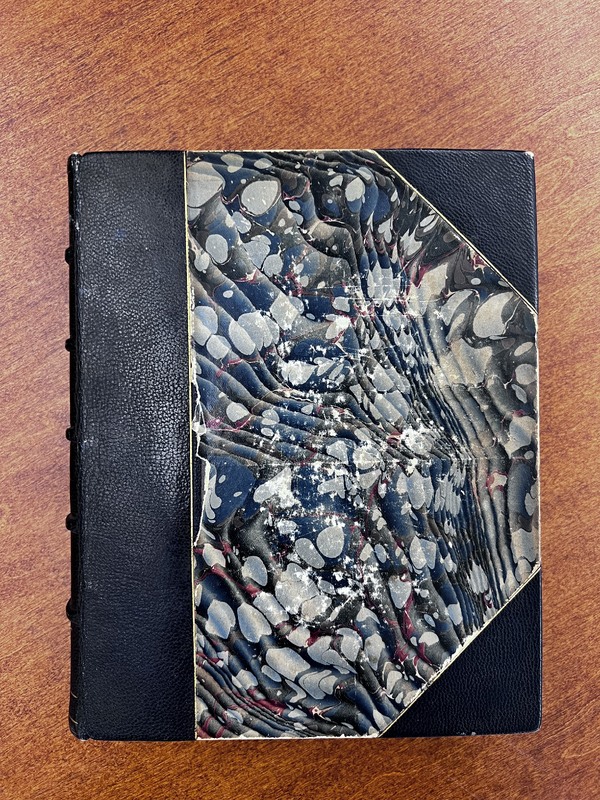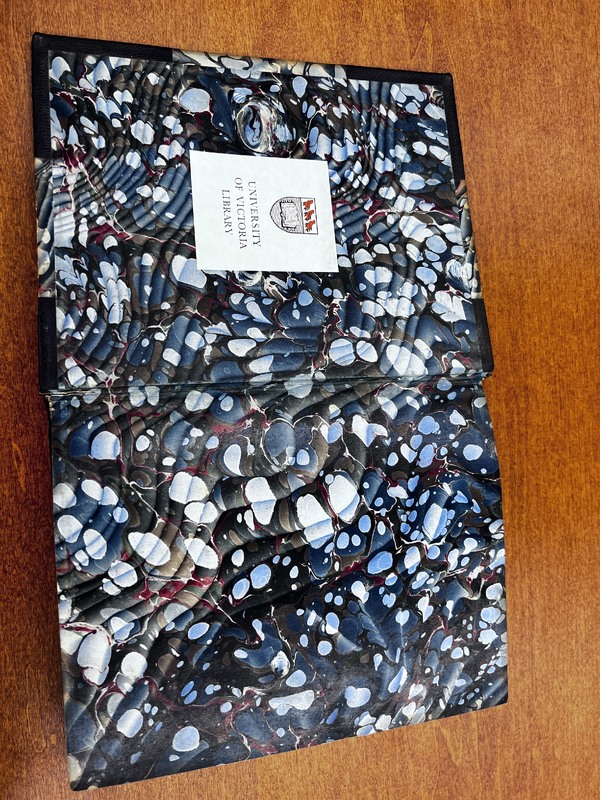Heather Mackay (Editions)
The object I have selected is “Ulysses by James Joyce, Shakespeare and Company 12, Rue de L’Odéon Paris 1925.” In order to better understand this selection, I have decided to focus my research around the topic of marketing and sales. I believe these to cohesively suit one another, as the aspect of marketing and sales, ties into the overall appeal of the object’s timely significance and popularity. Moreover, with marketing and sales in mind, I believe that obtaining more research of this 1925 edition will give us, the modern reader, a stronger grasp of the novels overall retained value. This can be seen through the extensive inability to obtain copies of these later editions, their exponential expenses and how in almost one hundred years the novels integrity remains strongly intact. Though the novel of Ulysses originally faced a vast range of criticism, this leads to the fact that marketing and sales weigh heavily on the novel’s notability.
At first glance this 1925 editions physique doesn’t relay that it is fact Ulysses, as the title is not displayed on the cover, nor James Joyce’s name but rather on the spine. This novel is a hard-covered copy, with black and gold crescents, dotted lines, as well as, the title and author presented on the spine. The front cover, the back and the inner lining of the novel, display a variety of blue, green and purple multi-coloured shapes, presumably representing bubbles and ripples. This could symbolize the sea or water, as Joyce pays a subtle ode to The Odyssey even before the reader begins the novel. In continuation, the main reason I chose this novel as my object was its cover. This simplistic design is rather eye catching upon display, as well as choosing to display the title and author on the spine draws the attention to the covers art design instead of words. With that being said, I also think the cover isn’t conventionally appealing, which is why it is a perfect fit for the cover of a novel like Ulysses.
Throughout my research I was able to find out more information regarding my selected 1925 edition of Ulysses, in combination with aspects of marketing and sales. I believe that this object and topic, will help me to gain more credible knowledge in an overall sense of Ulysses strategic marketing and sales. Moreover, when thinking of its earlier banishment in many countries and its continuous popularity to this day, it seems plausible that the aspects of the novels issues actually benefited and propelled the sales and marketing. I hope through this research it gives the modern-day reader a more suitable example of just how heavily sought after this novel is. I hope to discover if the aspects of the sales and marketing of Ulysses weighed into its exceedingly successful and well acclaimed novel, leaning towards the fact that it was so heavily scrutinized by early critics. I believe it’s popularity of being so inappropriate at the time of publication, caused it to become as popular as it is to this day and this would’ve had to do with its sales and marketing strategy.
Thinking critically, Ulysses banishment in the United States and Britain can be theoretically seen to have boosted its sales, mainly, the topic concerning obscene content, resulting in the novels banning, due to its uncommon content during the early 1920’s. Thus, narrowing my research to the perpetual notability of Ulysses, which can be seen through its sales and marketing, in relation to its banishment. Through Alistair McCleery’s article, “Banned Books and Publisher’s Ploys: The Well of Loneliness as Exemplar (2019),” the discussion of the United Kingdom’s choice to banish both Ulysses and The Well of Loneliness as Exemplarsoon after their publication date is brought to question. This introducing an almost new genre of writing. With Joyce sparking the curiosity of Radclyffe Hall, author of The Well of Loneliness as Exemplar, centred around provocative lesbian literature. It can be assumed that without the publication of Ulysses, Hall wouldn’t have gained the courage to publish his novel. Concluding that though both novels were to be banned, they remain very popular within the eighteenth- century realm of literature due to their provocative context.
Continuously, through Daniel R. Schwarz’s article, “Aesthetic Inclusion in Narrative Nonfiction: The Return of the Banished and Repressed (2015),” draws focus to Kevin Birmingham’s letters in regard to Ulysses. With the conceptual idea of Joyce’s narrative language throughout, Birmingham shares his opinionated stance regarding Ulysses, as he defends Joyce against the critiques who stated the novel was only full of filthy content. Schwarz’s believes that through Birmingham’s letters, we can look deeply into the core dilemmas of Ulysses. Just like any novel, criticism is evident, especially if the novel is written for a specific audience of readers. Similarly, Jessica Kim’s article, “A series originating in and repeated to identity: Identity, Relations, and the Fractal Imagination of “Ithaca (2019)””. Kim claims that when Ulysses is conceptualized through a modernistic viewpoint, the aspects of its artful structure, ties into its time of publication. With Kim’s article focusing solely on “Ithaca,” the aspects of art through music becomes apparent. Moreover, viewing Ulysses from a technical stance, the aspect of Joyce’s play on artful connotations is evident through not only “Ithaca” but the entirety of Ulysses.
Lastly, E. Paige Miller and Kiron Ward’s article, “Introduction to James Joyce’s Ulysses at 100: Still Learning (2022),” touches on how we as the modern reader are still learning and adapting to Joyce’s specific diction and stylistic way of writing. Miller and Ward also say that even after nearly 100 years since its original publication, Ulysses remains highly sought after and is still closely studied. I believe this information claims both credible acknowledgement and respect, as it is evident Ulysses will continue to be a sought after novel for decades to come. Throughout my research surrounding these four articles, I believe to have found clarity when applying them to my object at hand. Thinking critically with the application of this information, it is apparent that Ulysses sales and marketing, was heavily influenced by the novel’s original banishment, sparking the interest of common bystanders, avid literary critiques and renowned historical novelists.
Drawing focus back to my object of “Ulysses by James Joyce, Shakespeare and Company 12, Rue de L’Odéon Paris 1925,” my research pertained to the novels banishment during the early 1920’s. Relating these two components into one broader idea, it becomes evident that the objects significance in combination with its banishment, remain to coexist together. For without Ulysses seemingly foul language, related to its thematic attributes, it would not have gained as much attention as it has. When thinking critically of all the altering aspects that place Ulysses as one of the most controversial, yet popular novels over the last one hundred years, draws in a significant audience of readers. Moreover, the perpetuating abundance of obscene sexual remarks through the stylistic writing of Ulysses, relays the message of its drastic impact on the literary scene of the 1920’s.
Thinking from a stylistic approach of the contextual ideas of Ulysses, sex, sexuality and gender, play leading roles to its inevitable banishment. With remarks from Bloom’s masturbation at the view of young 17-year-old Gerty McDowell in “Nausicaa,” to male pregnancy and reconfiguring gender identity in “Circe,” were non the less seen as crude and foul for its publication time. Joyce’s specific writing narrative and diction was uncanny and obviously subjected to literary criticism. Even to the modern-day reader, Ulysses remains highly studied and criticized through its obvious inappropriateness, raising questions of awe and disgust. Looking more closely into “Nausicaa,” stylistically Joyce is clever at portraying Bloom’s perpetuating sexual desires through rhythmic lines. Joyce writes, “in raptures and it gushed out of it a stream of rain gold hair threads and they shed and ah!” (pp. 300, lines 738-739). Through these lines Bloom is ejaculating simultaneously as the fireworks blast and gleam in the sky. The personification of masturbation to the finale of a firework show, is indeed proficient and alluring. Though, also disturbing with the knowledge that Bloom was publicly masturbating on the beach (through his pants pocket), to the sight of an underage girl. When unpacking just this one line, the evidence of the abundance of sexual and crude activities Joyce writes about can be seen as boarder line pedophilic, predatorial and disturbing. Through the entirety of “Circe” the constant change to the sexuality of gender roles and Bloom’s desirable kinks are present. From the prostitutes in the brothel, to Bloom morphing into a pregnant woman. The obvious confusion comes as no surprise, but through the play-like episode Bloom’s sexual desires are elaborately apparent. Joyce writes, “O, I so want to be a mother” (pp. 403, line 1186). Presented here is Bloom stating his motherly desires, whether that be in combination with how he views women or diminishing a woman’s blessing of pregnancy.
Throughout Ulysses the abundance of sexual desires, sexuality and gender roles is significant. Moreover, it remains obvious that due to its obscene contents, Ulysses was simply too crude to remain as a published novel during the 1920’s. In conclusion, through research pertaining to my object’s significance and the novels banishment, it is evident that Joyce’s perpetually disturbing sexual remarks display how and why this novel was to become banned, as well as, highly sought after and popularized. I believe that through my research I was able to demonstrate an elaborate understanding and contribution of how the 1925 edition of Ulysses, produced high sales and marketing in the early 1920’s. This can be seen through its explicit content which contributed to its banishment and jump-started its popularization. Moreover, with the 1925 edition in hand, it is apparent that its high demand in book sales following its banishment, contributed a high spike in its literary history, as well as, its popularity and significance. Ulysses defied and challenged the nature of literature for its time, thus, enhancing and changing the ideologies of writing and writers, which is seen in the modern day twentieth century. I believe that Ulysses will remain to be a highly sought- after novel, just as it has for the last nearly 100 years and will for many more decades to come.
Heather Mackay (Editions)
Kim, Jessica. ""A series originating in and repeated to infinity": Identity, Relations, and the Fractal Imagination of "Ithaca"." James Joyce Quarterly, vol. 56 no. 3, 2019, p. 289-309. Project MUSE, doi:10.1353/jjq.2019.0069.
McCleery, Alistair. "Banned Books and Publishers' Ploys: The Well of Loneliness as Exemplar." Journal of Modern Literature, vol. 43 no. 1, 2019, p. 34-52. Project MUSE muse.jhu.edu/article/745756.
Miller, Paige E. Ward, Kiron. “Introduction to James Joyce’s Ulysses at 100: still learning, Textual Practice.” 36:2, 2022 , p. 182-185, DOI: 10.1080/0950236X.2022.2003093
Schwarz, Daniel R. "Aesthetic Inclusion in Narrative Nonfiction: The Return of the Banished and Repressed." Narrative, vol. 23 no. 3, 2015, p. 349-355. Project MUSE, doi:10.1353/nar.2015.0023.




